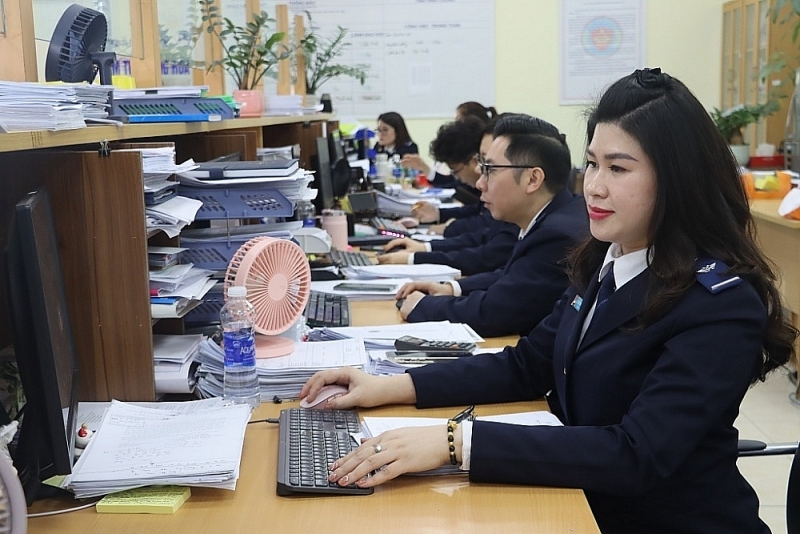 |
| Professional activities at Hai Phong Customs Department. Photo: T.Binh |
Electronic customs procedures create a breakthrough reform
In a report just sent to the National Assembly, the Ministry of Finance said that, with the efforts of the entire Customs sector, the contents of customs procedures, customs inspection and supervision have been simplified, harmonized, and regulations Customs management is standardized following the revised Kyoto Convention.
Customs procedures are carried out mainly electronically; apply risk management methods that have rapidly developed; post-customs clearance inspection erates professionally; Deploying the National Single Window and ASEAN Single Window; develop and apply special priority regimes; Build and develop a system for pre-determination of customs value, classification of goods and origin of goods; Customs clearance agents were built and developed, gradually becoming an important bridge between Customs and organizations and individuals importing and exporting goods.
Specifically, customs procedures are simplified, harmonized, and consistent with international standards and practices in the following aspects: eliminating requests for providing duplicate and overlapping information and documents; clearly define customs management procedures and regimes based on recommendations and standards of the revised Kyoto Convention; harmonize customs procedures and regimes with the same content and nature of a standard procedure and management regime based on the recommendations of the revised Kyoto Convention.
The VNACCS/VCIS automatic electronic customs clearance system is deployed at 100% of customs departments and customs branches across the country, with 100% of basic customs types, over 99.56% of all businesses implementing customs procedures, reaching 99.32% of total import-export turnover and more than 99.63% of total customs declarations nationwide.
The Ministry of Finance assesses that the implementation of electronic customs procedures has created a breakthrough reform, comprehensively changing the method of declaring and submitting customs documents from manual to electronic. The processing of feedback from the Customs agency to businesses is also done through the electronic system, greatly facilitating import and export activities, minimizing documents and paperwork and simplifying customs records in the process. stages and steps in implementing customs procedures, reducing contact between customs officials and businesses, limiting troubles, negativity, harassment, and reducing time and costs for businesses. Receiving and customs clearance time for Green channel declaration is only one to three seconds.
Applying achievements of the 4th Industrial Revolution
Overcoming shortcomings and limitations in recent times and meet higher development goals in the coming years, according to the Ministry of Finance, in the coming time it will continue to build and perfect the customs legal system. modern, synchronous, unified, transparent, consistent with international commitments; ensure customs procedures, customs inspection and supervision are applied.
Specifically, apply a chain management approach with the implementation of an integrated supply chain management model according to the guidance in the Security and Trade Facilitation Framework (SAFE) of the World Customs Organization (WCO); Value chain management meets state management requirements on customs for the entire production and business process of the enterprise.
Redesigning the system of customs procedures, customs inspection and supervision as a basis for building a Digital Customs model according to the Digital Government architecture, Smart Customs according to WCO recommendations with a digital level increasing automation and automation.
Implementing a smart customs border management model according to WCO recommendations ensures that Customs authorities can monitor and control goods from input of raw materials to production, processing, and transportation. transferred from the exporting country to the importing country.
Implement Green Customs, encourage and promote trade activities towards sustainable development according to the circular economy model through effective implementation of international treaties on environmental and wildlife protection that Vietnam has signed. At the same time, there are measures to encourage import-export businesses to implement solutions according to the circular economy model. Effectively monitor and control the movement of goods across borders, promptly prevent violations affecting human health, the environment, and wildlife protection ecosystems.
Effectively implement the Project on reforming the quality inspection and food safety inspection model for imported goods.
Building and implementing a centralized customs clearance model through the formation of centralized customs document inspection locations at Regional Customs, building and deploying a model of centralized physical inspection locations for goods, applying modern technology, machinery and equipment in inspection, supervision and customs control in accordance with the actual situation.
Deploying synchronously and fully the application of risk management in customs operations.
In parallel, there is the application of advanced science and technology of the 4th Industrial Revolution such as: Internet of Things (IoT) connection, artificial intelligence (AI), big data (Bigdata), analytics intelligence (BI)… to improve the effectiveness of risk management operations.
Regarding solutions for investing in infrastructure, modern equipment, building an information technology system to implement Digital Customs, it meets the requirements of institutional reform and in accordance with the requirements of Government building. e-government, digital government.
Upgrading the National Single Window Portal and ASEAN Single Window systems to meet connection and information sharing requirements to serve the automatic processing of the digital customs system.
Investing in modern equipment to support the implementation of customs procedures and customs inspection and supervision based on the implementation of the digital Customs system.
